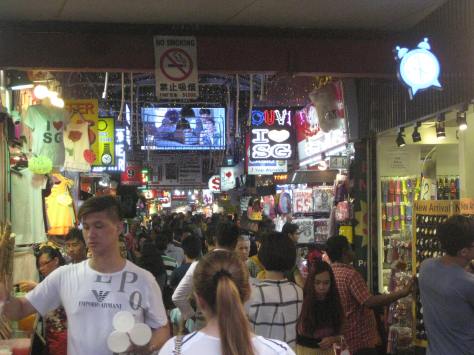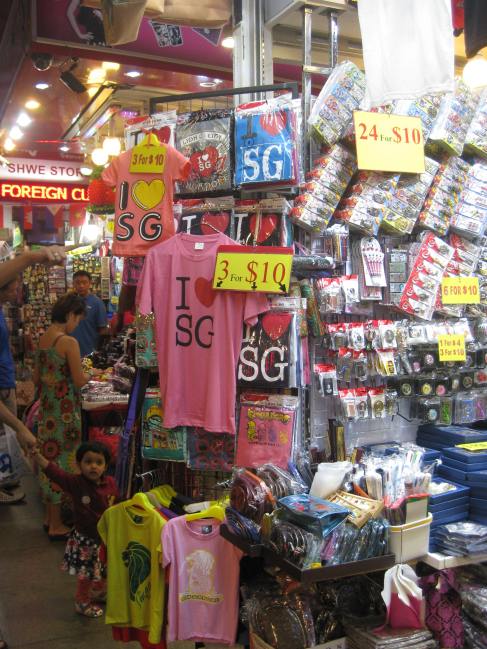
Traveling is often conceptualized as a passive activity, as though seeing new places enriches you somehow when you gather new experiences. Yet, it often turns out to be more about active self-discovery than about seeing a new place, about experience that could not have happened exactly the same way without you, the active agent at the center. In the following post about Bugis, I admit that I’ve been unashamedly at the center of my experience far more than Bugis.
When you place yourself against something sublime or complex in front of you, such as a man-made building or a natural structure, a teeming marketplace or a superbly constructed mall-airport, you think you’re simply soaking it all in in wonder because that grand structure is an objective thing and you are the observer.
Yet, many grand experiences, when you encounter them for the first time, and some grand experiences when you encounter them every time, have the potential of changing you because you don’t just see the object in front of you. You see yourself from yet another perspective, one you hadn’t quite seen yourself from before.
Encountering new experience becomes about altering, rearranging and re-thinking the old experiences which had structured the topography of your mind thus far, which you had become habituated with, which you had inhabited for a while. Your world changes ever so slightly when you see a different kind of architecture, a different way of life, a different set of people, a different history, a different center for the world of a different set of people, about seeing how a different set of people had reacted to the same forces of imperialism and change and adapted in different ways than you.
And then there are places that are very similar to what you have been used to, some exactly the same, some an enhancement of what you already know, some a bit of a sad imitation of a place you have seen before. In our globalized world, such spaces are becoming more and more common and these are the places far easier to find online and on guidebooks than places that are different. Sometimes these spaces, so wonderfully characterized by sameness, are mind bogglingly spectacular reminding you of spaces that are better or worse than what you’ve seen before making you feel like that first experience was more genuine and the current one merely an imitation.


Singapore, for an outsider like me, has been very easy to navigate with its awesome public transportation, clear maps and friendly people everywhere who speak a language I can understand in some shape or form and food, glorious food everywhere. I have not seen such dazzling architecture and such clean bus and train stations and such orderly crowds who respect rules anywhere else despite the huge numbers of people and despite the fact that anything man made that exists does so against a fierce struggle with the elements-: a harsh burning sun, very high humidity, moss, algae, insects, putrefaction that happens almost overnight to anything left alone for a bit four degrees North of the equator.
Despite such obvious advantages that lend clarity about the city to an outsider, from the moment I landed on the fabulous Changi airport, I have struggled to find those places on online sites and guidebooks that tell a long-time story of Singapore.
The Singapore that may not be so fabulously fabulous and yet could be a perspective-altering experience for someone who comes to its shores.
I know it exists. Layers and layers of history peek out of the city in the way people dress, in the hybrid languages they speak, in the food they eat, in people’s names and the various systems they have for identifying themselves and in the way they behave differently in different public spaces. It is a place of Chinese temples and Indian temples and Indonesian mosques and ordered housing complexes and malls and spectacular streets and waterfronts. It is a place where people look at their smartscreens as they walk on the pavement and stand in the trains and a place where people crowd around huge statues of ancient figures to find out their fortunes at temples and carnivals. It is a place where everything is automated but there is a human helping out right behind the machine when you need them. It is a place where people keep within the yellow line as they walk if a sign says they should.
Within this non-chaotic chaos of a populous city-state I found my spot on the island. Or rather, the spot found me. A place I wouldn’t have found as a must visit if I had taken online advice too seriously.
I can’t quite remember when or how it was that I landed up in Bugis. But once I found it, I have realized now that I keep going back every few weeks. I wonder what it is that makes me keep coming back. It isn’t as grand as the Esplanade area with its spectacular architecture nor as distinctive to the tourist as Little India or Chinatown. It isn’t as full of grand old buildings like the City Hall area or as fascinating as the Botanical gardens with its old trees and herbs and orchids and the rainforest.

I have only scratched the surface of Bugis till now. The placards tell me about the Bugis people who came here from the Sulawesi province of Indonesia as maritime traders after the British established a trading settlement in Singapore in the early nineteenth century. They dominated trade in the Malay archipelago until Western ships achieved dominance later in the century. The English word “bogeyman” seems to have originated in reference to the Bugis, ruthless seafarers and pirates (smiley face here) who seemed to have plagued the early English and Dutch trading ships.
For all practical purposes, all this information is available to me via a few placards placed in between carts selling scarves and handbags and make-up in a superb covered part of Bugis junction in between big stores exhibiting major fashion labels and sales announcements. There is, of course, no sign of the transwomen who roamed the area attracting Western tourists a few decades ago in nearby Bugis street which is completely reconstructed now.

Yet, the cobbled paths, the street shops, the huge Hawker Center, the stores that sell cheap clothes and tropical fruits and juices and confectionary keep making me come back many times over. Along with the lychee and the rambutan and the dragonfruit and the pineapple there is always the inimitable durian in the fruit stands. This place is very different from the nearby mall, which is fascinating in its own way but could have belonged to other places too.
But Bugis carries glimpses of uniqueness. Perhaps that is why I keep coming back here.








thank,s
LikeLike
like it
LikeLike
verry nice
LikeLike
i like it
LikeLike
I love Indonesia…but i hope someday i get travelling to singapore
LikeLike
Like this artickle
LikeLike
like this article
LikeLike
I Like Singapore. There is so many beautiful place..
LikeLike
I hope, some day I can travelling to singapur…
LikeLike
I love Indonesia, nice article, I like it
LikeLike
In Indonesia, almost all the area is a tourist place, because Indonesia is composed of islands. So rich in beautiful beaches and panoramic views, as it also supported by season friendly because it only has two seasons, the rainy season and summer.
LikeLike
what you love beautiful places ??? in Indonesia are also many beautiful places, such as Bali, Lombok, etc., please you come to visit
LikeLike
Lombok Island is also more beautiful than Bali. If you do not believe, please see for yourself. Because tourism in Lombok Island beaches are still beautiful. I wait for you to visit the island of Lombok .
LikeLike
I’ve never been to Singapore, so I enjoyed your photos and narrative very much. What I liked best is the second part of your post. Every city has a secret one, one that insiders know best. I love how you write about your discovery of Bugis and why you keep returning, favoring the less refined streets to the malls or other modern buildings that tend to llok very similar, despite different architectures. I feel the same way in Paris, which has still (too few!) unsophisticated areas that no tourist can easily find. This is where you can have a glimpse on people’s lives.
As always this is a great post, Bottleworder.
LikeLike
Will you come to Indonesia especially to BALI? Bali is in Indonesia and that’s an awesome Island of Indonesia, I think you have to go there 🙂
LikeLike
I would love to go to Bali.
LikeLiked by 1 person
Glad to know that, have fun ^^
LikeLike
Reblogged this on oshriradhekrishnabole.
LikeLike
This is very healthy or me, as the Singapore I know dates from about the 1920s (many photos of my grandparents lives) to the 1950s. In the 1970s I was wearing a BIG dress I made with material sent from Singapore to my grandmother by an old friend.
LikeLike
Wow! Singapore must have been way different back then. It’s changed so fast.
LikeLike
I LOVE Singapore! I only wish it wasn’t so expensive to stay there. Talking about the Bugis, they make the most beautiful boats. They’re called “Bugis Schooners”. I went to Sulawesi Island a couple of years ago to see about having one built for me, but prices had already gone up too much.
LikeLike
really? fascinating. . .
LikeLiked by 1 person
yeah. I took a trip over there. I think I have already posted some pictures. Let me see if I have a good one. For now, heres a link from google. https://www.google.no/search?q=Bugis+schooner+images&espv=2&biw=1745&bih=865&tbm=isch&tbo=u&source=univ&sa=X&ved=0CBwQsARqFQoTCPDY4-3E5cYCFev8cgodYPwEmw
LikeLike